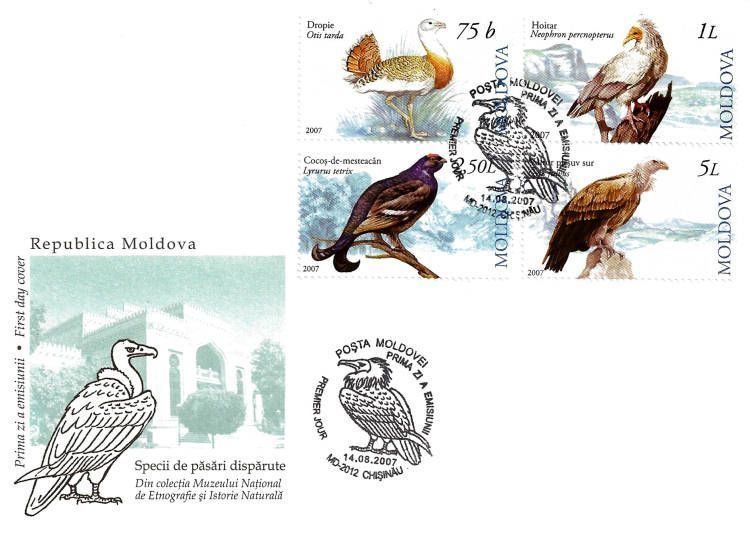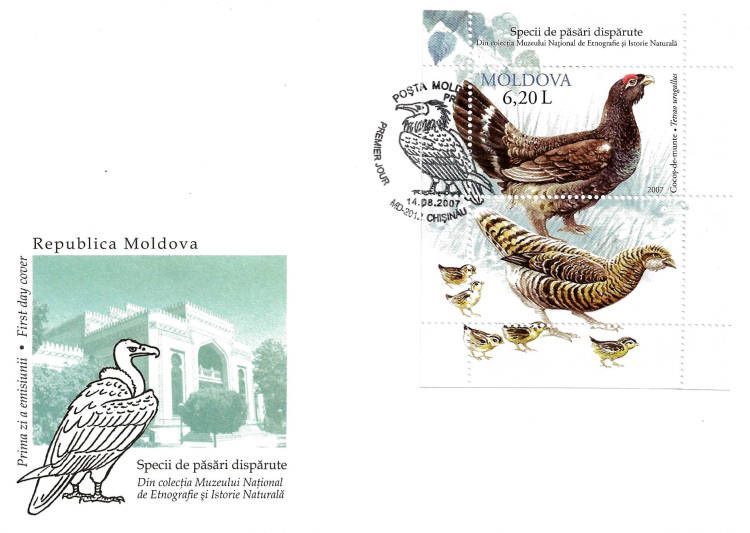POSTAGE STAMPS
|
|
Great Bustard (Otis Tarda)
- Michel Catalogue No: 590
- Perforation Type/Size: Comb 14:14.50
- Size: 46.00 x 27.50 mm
- Face Value: 0.45 Lei
- Quantity Printed: 400,000
|
The Great Bustard (Otis tarda) is in the bustard family, the only member of the genus Otis. It breeds in southern and central Europe, where it is the largest species of bird, and across temperate Asia. European populations are mainly resident, but Asian birds move further south in winter. Portugal and Spain now contain about 60% of the world's population. Read more..
This article uses material from the Wikipedia article 'Great_Bustard', which is released under the Creative Commons Attribution-Share-Alike License 3.0. |
| |
|
Egyptian Vulture (Neophron Percnopterus)
- Michel Catalogue No: 591
- Perforation Type/Size: Comb 14:14.50
- Size: 46.00 x 27.50 mm
- Face Value: 1 Lei
- Quantity Printed: 500,000
|
The Egyptian Vulture (Neophron percnopterus), also called the White Scavenger Vulture or Pharaoh's Chicken, is a small Old World vulture and the only member of the genus Neophron. It is widely distributed; the Egyptian Vulture is found from southwestern Europe and northern Africa to India. The contrasting underwing pattern and wedge-shaped tail make it distinctive in flight as it soars in thermals during the warmer parts of the day. Egyptian Vultures feed mainly on carrion but are opportunistic and will prey on small mammals, birds, and reptiles. They also feed on the eggs of other birds, breaking larger ones by tossing a large pebble onto them. The use of tools is rare in birds and apart from the use of a pebble as a hammer, Egyptian Vultures also use twigs to roll up wool for use in their nest. Egyptian Vultures that breed in the temperate regions migrate south in winter while tropical populations are relatively sedentary. Populations of this species have declined in the 20th century and some island populations are endangered by hunting, accidental poisoning, and collision with power lines. Read more..
This article uses material from the Wikipedia article 'Egyptian_Vulture', which is released under the Creative Commons Attribution-Share-Alike License 3.0. |
| |
|
Black Grouse (Lyrurus Tetrix)
- Michel Catalogue No: 592
- Perforation Type/Size: Comb 14:14.50
- Size: 46.00 x 27.50 mm
- Face Value: 2.5 Lei
- Quantity Printed: 50,000
|
The Black Grouse or Blackgame (Tetrao tetrix) is a large game bird in the grouse family. It is a sedentary species, breeding across northern Eurasia in moorland and bog areas near to woodland, mostly boreal. The Black Grouse is closely related to the Caucasian Grouse. Read more..
This article uses material from the Wikipedia article 'Black_Grouse', which is released under the Creative Commons Attribution-Share-Alike License 3.0. |
| |
|
Griffon Vulture (Gyps Fulvus)
- Michel Catalogue No: 593
- Perforation Type/Size: Comb 14:14.50
- Size: 46.00 x 27.50 mm
- Face Value: 5 Lei
- Quantity Printed: 50,000
|
The Griffon Vulture (Gyps fulvus) is a large Old World vulture in the bird of prey family Accipitridae. Read more..
This article uses material from the Wikipedia article 'Griffon_Vulture', which is released under the Creative Commons Attribution-Share-Alike License 3.0. |
| |
|
Western Capercaillie (Tetrao Urogallus)
- Michel Catalogue No: 594
- Perforation Type/Size: Comb 14:14.50
- Size: 46.00 x 27.50 mm
- Face Value: 6.2 Lei
- Quantity Printed: 20,000
|
The Western Capercaillie (Tetrao urogallus), also known as the Wood Grouse, Heather Cock or Capercaillie /ˌkæpərˈkeɪli/, is the largest member of the grouse family. The largest known specimen, recorded in captivity, had a weight of 7.2 kg. (15.9 lbs). Found across Europe and Asia, it is renowned for its mating display. Read more..
This article uses material from the Wikipedia article 'Western_Capercaillie', which is released under the Creative Commons Attribution-Share-Alike License 3.0. |
| |









No comments:
Post a Comment